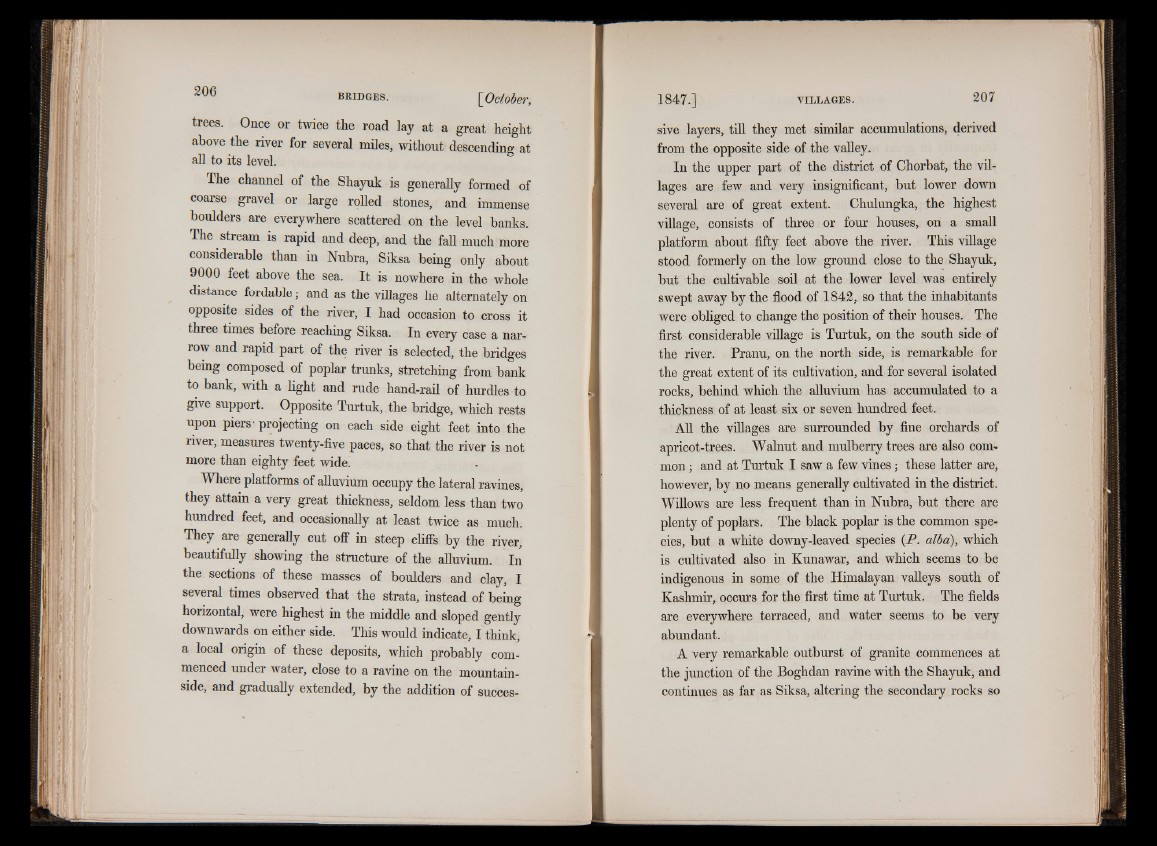
trees. Once or twice the road lay at a great height
above the river for several miles, without descending at
all to its level.
The channel of the Shayuk is generally formed of
coarse gravel or large rolled stones, and immense
boulders are everywhere scattered on the level banks.
The stream is rapid and deep, and the fall much more
considerable than in Nubra, Siksa being only about
9000 feet above the sea. It is nowhere in the whole
distance fordable; and as the villages he alternately on
opposite sides of the river, I had occasion to cross it
three times before reaching Siksa. In every case a narrow
and rapid part of the river is selected, the bridges
being composed of poplar trunks, stretching from bank
to bank, with a light and rude hand-rail of hurdles to
give support. Opposite Turtuk, the bridge, which rests
upon piers- projecting on each side eight feet into the
river, measures twenty-five paces, so that the river is not
more than eighty feet wide.
Where platforms of alluvium occupy the lateral ravines,
they attain a very great thickness, seldom less than two
hundred feet, and occasionally at least twice as much.
They are generally cut off in steep cliffs by the river,
beautifully showing the structure of the alluvium. In
the sections of these masses of boulders and clay, I
several times observed that the strata, instead of being
horizontal, were highest in the middle and sloped gently
downwards on either side. This would indicate, I think,
a local origin of these deposits, which probably commenced
under water, close to a ravine on the mountainside,
and gradually extended, by the addition of successive
layers, till they met similar accumulations, derived
from the opposite side of the valley.
In the upper part of the district of Chorbat, the villages
are few and very insignificant, but lower down
several are of great extent. Chulungka, the highest
village, consists of three or four houses, on a small
platform about fifty feet above the river. This village
stood formerly on the low ground close to the Shayuk,
but the cultivable soil at the lower level was entirely
swept away by the flood of 1842, so that the inhabitants
were obliged to change the position of their houses. The
first considerable village is Turtuk, on the south side of
the river. Pranu, on the north side, is remarkable for
the great extent of its cultivation, and for several isolated
rocks, behind which the alluvium has accumulated to a
thickness of at least six or seven hundred feet.
All the villages are surrounded by fine orchards of
apricot-trees. Walnut and mulberry trees are also common
; and at Turtuk I saw a few vines; these latter are,
however, by no means generally cultivated in the district.
Willows are less frequent than in Nubra, but there are
plenty of poplars. The black poplar is the common species,
but a white downy-leaved species (P. alia), which
is cultivated also in Kunawar, and which seems to be
indigenous in some of the Himalayan valleys south of
Kashmir, occurs for the first time at Turtuk. The fields
are everywhere terraced, and water seems to be very
abundant.
A very remarkable outburst of granite commences at
the junction of the Boghdan ravine with the Shayuk, and
continues as far as Siksa, altering the secondary rocks so